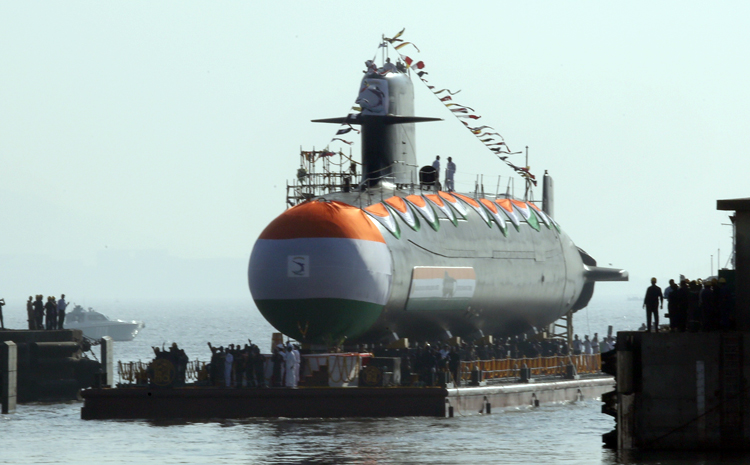INDIAN ARMED FORCES CHIEFS ON
OUR RELENTLESS AND FOCUSED PUBLISHING EFFORTS

SP Guide Publications puts forth a well compiled articulation of issues, pursuits and accomplishments of the Indian Army, over the years

I am confident that SP Guide Publications would continue to inform, inspire and influence.

My compliments to SP Guide Publications for informative and credible reportage on contemporary aerospace issues over the past six decades.
- Prime Minister witnesses 'Bharat Shakti' – a Tri-Services Firing and Manoeuvre Exercise in Pokhran, Rajasthan
- Interim Defence Budget 2024-25 — An Analysis
- Union Defence budget 2024
- Prime Minister Modi Commemorates Indian Navy Day in a Grand Ceremony
- Prime Minister Modi Flies in the LCA Tejas
- New Chapter in India-Italy Defence Ties
- Airpower beyond Boundaries
India nullifies its biggest reform in Defence Procurements
Public Sector gate crashes into the Strategic Partner Model meant to create significant Defence Manufacturing capabilities in the Private Sector

India has taken a step back from its most ambitious reform in Defence Procurement. It has virtually nullified the Strategic Partner Model which was an attempt to break the monopolistic stranglehold of a slothful Public Sector over Defence Production and give a fair opportunity for Private Sector companies to emerge as international standard manufacturers and integrators of whole systems and platforms.
This development was confirmed on July 8 by the Indian Navy's Controller of Warship Production & Acquisition, Vice-Admiral AK Saxena in New Delhi while responding to media queries at a press conference to announce an international seminar on shipbuilding.
The concept was that the Strategic Partner should make massive investments to establish the infrastructure and skills and leverage private sector enterprise to emerge as a global standard manufacturer, and in return be assured of long-term business to keep the production pipeline going. Some procurements were meant to be made exclusively from the Strategic Partner route
The concept of Strategic Partner was incorporated in Chapter 7 of the Defence Procurement Procedure (DPP), 2016. It was meant to award contracts for construction of military platforms like fighter aircraft, helicopters, submarines, tanks and armoured fighting vehicles to Indian private sector companies selected through a competitive process. Companies selected as Strategic Partner separately for different platforms were meant to tie-up with foreign OEMs shortlisted in a parallel selection process as technology providers.
The concept was that the Strategic Partner should make massive investments to establish the infrastructure and skills and leverage private sector enterprise to emerge as a global standard manufacturer, and in return be assured of long-term business to keep the production pipeline going. Some procurements were meant to be made exclusively from the Strategic Partner route.
The first two programmes flagged off recently under the Strategic Partner model are important, multi-billion naval procurements for 6 diesel-electric submarines and 111 utility ship-borne helicopters.
The Navy's Controller of Warship Production & Acquisition acknowledged two major dilutions to the Strategic Partner concept which now reduce it to the pre-reform Buy and Make (India) category of Defence Procurements: One, that the Indian Public Sector companies will be allowed to bid for consideration as Strategic Partner along with the Private Sector, and Two, that a Strategic Partner will not be nominated for long-term procurement of a particular platform, for example fighter aircraft or and submarines over, say, two decades, but only for a limited, specific procurement programmme.
The first two programmes flagged off recently under the Strategic Partner model are important, multi-billion naval procurements for 6 diesel-electric submarines and 111 utility ship-borne helicopters.
The company nominated as Strategic Partner for one programme in one line of production like, say, helicopters or tanks, would have to compete all over again for a second programme for the same category of platforms at a later date.
India's public sector aerospace manufacture monopoly HAL and its subsidiary have bid in the Naval Utility Helicopter Programme, while Public Sector shipyards led by Mazagon Docks Limited are expected to respond to the Expression of Interest recently issued in the Project 75 (India) submarine construction programme.
"The decision taken by the Government is in front of you," Vice-Admiral Saxena said, referring to the Public Sector bidding being allowed in the Strategic Partner programmes.

The Private Sector lament is that it will not be able to compete on cost against the Public Sector, whose infrastructure has been set up with decades of State investment, and would thus not involve heavy incremental cost for a new programme. But the Private Sector would have to make massive investments in creating infrastructure ab initio, which would be reflected in much higher costs for a single procurement programme.
At the press conference addressed by the Navy's Controller of Warship Production & Acquisition, senior representatives of the Private Sector vent out their protest with uncharacteristic candour.
"Once the PSUs are allowed, fair comparison is not possible on an apple-to-apple basis," said Commodore Mukesh Bhargava (Retired), executive director of L&T, which has set up a shipyard at Katupalli in Tamil Nadu and is now awaiting an opportunity to be allowed to emerge as a warship builder. He stressed that the issue of fresh investment required by the private sector must be taken into consideration for fair playout of the Strategic Partner model. There must be assurance of continued orders to justify the investment by Industry in Defence Production capability.
The Navy's Controller of Warship Production & Acquisition acknowledged two major dilutions to the Strategic Partner concept which now reduce it to the pre-reform Buy and Make (India) category of Defence Procurements: One, that the Indian Public Sector companies will be allowed to bid for consideration as Strategic Partner along with the Private Sector, and Two, that a Strategic Partner will not be nominated for long-term procurement of a particular platform
His views were echoed by Commodore Sujeet Samaddar (Retired), Advisor to the Federation of Indian Chambers of Commerce and Industry (FICCI). "The Strategic Partner approach cannot be on a batch production model. This is a key constraint. We have to move from batch production to pipeline production," he said, arguing for assured orders for a new, international standard pipeline which would require huge investment to set up.
"The Strategic Partner should be able to amortise, say, a $2 Billion investment for submarine production over not six submarines but 20," Commodore Samaddar reasoned, making a case for "long-term procurement-cum-maintenance contracts". Offering another example, he said when the long-term requirement is for 24 minesweepers for the Indian Navy, the approach must not be focussed on part or bit procurement from a manufacturer identified through a competitive process. Procurement must continue for all 24 minesweepers from the same production line, he argued.
Responding to a question from SP's on how the diluted Strategic Partner Model was different from the pre-existing Buy and Make (Indian) category, Vice-Admiral Saxena said, "The difference is in transfer of technology and skills by the foreign OEM."





